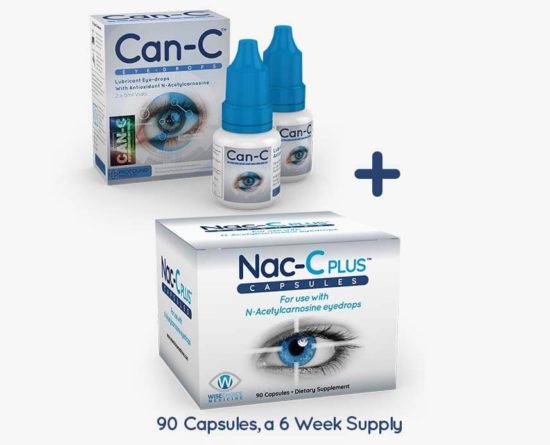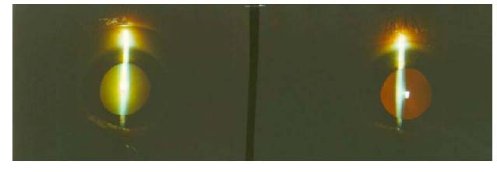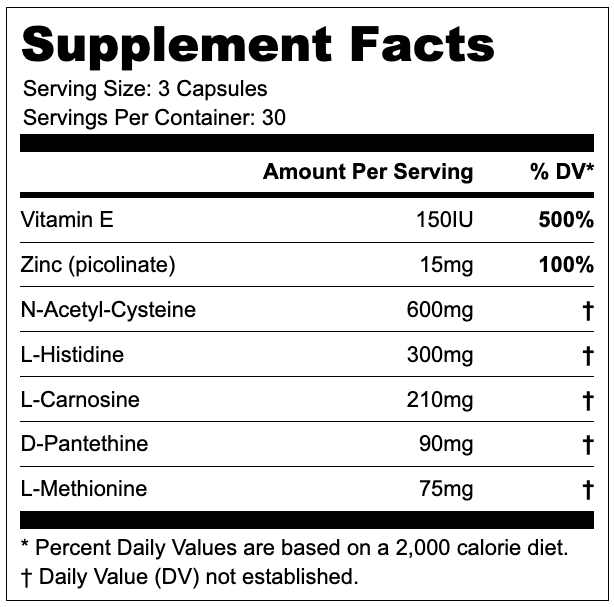March is Save Your Vision Month - click here for FREE healthy vision tips

Patients with ripe cataract further support vision with combination of Can-C Eye Drops and Nac-C Plus Capsules
Last Updated on November 18, 2023
Table of Contents
A Breakthrough, From Wise Choice Medicine.
- The original formula, developed by the inventors of Can-C™ Eye Drops.
- Designed for use with Can-C™ eye-drops.
- Increases the potency of Can-C™ Eye Drops and the length of time that the drops remain active in the eye.
- Accelerated healing response when combined with Can-C eye drops.
- Enhanced free radical protection and reduction of oxidation within the eye.
- Glaucoma support information

Dr. Mark Babizhayev, a leading biophysicist in the area of natural peptides and their unique ability to reverse oxidation has developed and patented this specific oral formulation to effectively sustain the activity of Can-C eye drops for longer periods within the eye tissues.
When taken consistently with Can-C eye drops, Nac-C Plus increases the length of time that the Can-C eye drops remain active in the eye, by preventing and slowing the break down of carnosine once it has been topically delivered. This sustaining action greatly improves free radical protection and further reduces the oxidative environment within the eye allowing for an accelerated healing response.
We know that Can-C™ eye drops are highly effective on their own and are a stand alone product for the reversal of many ocular conditions. Nac-C Plus™ is a complementary supplement for those who want to maximize their effort with the use of Can-C™ eye drops. In addition, those who have more mature cataract with measurably diminished vision will greatly optimize their effort by taking Nac-C Plus in addition to their daily applications of Can-C™ eye-drops.
Nac-C Plus has been formulated, approved and patented by the inventors of the Can-C eye-drop technology. Designed to be used with Can-C eye-drops, Nac-C Plus™ taken orally helps to support the effectiveness and optimize the action of Can-C eye drops.
Synergism of histidyl dipeptides and amino acids proven to be benefical in ophthalmic treatments.
With the knowledge that there is a natural range of the histidyl dipeptides within mammalian tissues we have investigated possible synergism between them in respect of antioxidant activity in ophthalmic treatments.
Considering the efficacy of N-acetylcarnosine eye drops in the therapeutic treatment of ripe cataracts, we now theorize that, declining visual acuity, along with the onset of ‘halo’ effects and vitreous lesions, including floaters and even elevated IOP, may be a result of diminished Glutathione levels within the eye.
“New research supports the protective effect of vitamin E, N-acetylcysteine as well as mitochondrial permeability transition (MPT) inhibitors in the management POAG” Dr. Yuan He more information In a separate pilot study, ripe, human, age-related, cataract is significantly reversed over a period of 5 months, with the application of Can-C™ N-acetylcarnosine eye drops (2 drops twice daily) combined with Nac-C Plus™, 1 tablet (two times daily).
Powerful antioxidant protection for the eyes…
We found that the L-Histidine ingredient in the Nac-C Plus formulation acts synergistically with other natural imidazole containing Peptidomimetics (N-acetylcarnosine, L-carnosine) as antioxidants. Our results show that combining imidazole containing compounds at near physiological concentrations results in heightened synergistic anti-oxidant activity. The clinical and experimental data demonstrate the improved effectiveness and safety of the combined treatment modality.
The oral consumption of the N-acetyl-cysteine ingredient in Nac-C Plus, boosts reduced glutathione levels in the human crystalline lens. As indicated in the Figure 1, ripe age-related cataract is significantly reversed within 5 months of combined treatment.

Figure 1:
Left image: pronounced opacities in the lens layers prior cataract treatment;
Right image: An appearance of the rose reflex visible through the lens which became significantly more transparent after 5 months of combined treatment of cataract with the N-acetylcarnosine eye drop combined with the oral supplementation of Nac-C Plus.Conclusion: Manipulation with chemical chaperones; N-acetylcarnosine, carnosine, D- pantethine or regulated/inducible molecular chaperone protein function (such as alpha-crystallin chaperone activity in the lens) offers novel therapies for reversal of (ripe) cataracts, retinal degeneration and ocular complications of diabetes.
Clinically Proven Ingredients
Other Ingredients: Micro-crystalline Cellulose, Di Basic Calcium Phosphate, Magnesium Stearate, Aerosil, Vegetarian Capsule.
Vitamin E
Shown to reduce cataract risk, Vitamin E (AKA alpha-tocopherol) is a fat-soluble antioxidant found in the membranes and lens fibers of the eye. It is thought to reduce degradation of lens lipids and stabilize the cell membranes of the lens, thereby protecting against cataracts. Several studies have demonstrated that low vitamin E levels are associated with increased cataract risk(1) while higher vitamin E consumption protects against cataract formation.(2)
- Olmedilla B, et al. Serum status of carotenoids and tocopherols in patients with age-related cataracts: a case-control study. J Nutr Health Aging 2002;6(1):66-8. https://pubmed.ncbi.nlm.nih.gov/11813087/
- Robertson J M, et al. Vitamin E intake and risk of cataract in humans. Ann NY Acad Sci 1993; 372-82. https://pubmed.ncbi.nlm.nih.gov/2629606/
Zinc
Zinc is vital to keeping your eyes healthy and vision sharp. Zinc is concentrated in a part of the retina called the “macula” and helps Vitamin A produce melanin, a pigment which has a protective effect on the eye. A deficiency in zinc has been associated with reduced night vision, while supplementation with zinc has been shown to slow the rate of age-related macular degeneration due to its importance in maintaining a healthy macula.(1) Zinc has also been shown to reduce cataracts by as much as 36% in people ages 65-74.(2)
- Blasiak J, et al. Zinc and Autophagy in Age-Related Macular Degeneration. Int J Mol Sci. 2020 Jul; 21(14): 4994. https://www.ncbi.nlm.nih.gov/pmc/articles/PMC7404247/
- Sperduto R D, et al. The Linxian cataract studies. Two nutrition intervention trials. Arch Ophthalmol. 1993 Sep;111(9):1246-53. https://pubmed.ncbi.nlm.nih.gov/8363468/
N-Acetyl-Cysteine
Glutathione is especially concentrated in the lens of the eye, and when it is depleted due to aging or oxidative stress it can cause cataract formation.(1, 2) That’s because glutathione is key to protecting lens flexibility and clarity, acting as a very powerful antioxidant to shield proteins and enzymes from oxidative stress caused by free radicals.(3) That means glutathione is something we want more of. Orally-administered N-Acetyl-Cysteine supports the glutathione sparing effects of Can-C™ eye drops and further increases tissue glutathione levels in the eye.
- Kamei A. Glutathione levels of the human crystalline lens in aging and its antioxidant effect against the oxidation of lens proteins. Biol Pharm Bull 1993; 16(9); 170-5.
- Oguchi M, et al. Glutathione and eye diseases. Ganka, 1970; 12: 125-32.
Giblin FJ. Glutathione: a vital lens antioxidant. J Ocul Pharmacol Ther 2000 Apr; 16(2):121-35.
L-Histidine
L-Histidine works synergistically with L-Carnosine and N-Acetylcarnosine to create heightened antioxidant activity, thereby protecting the eye from cataract-causing damage.(1) Clinical trials have shown that adding L-Histidine to other “natural imidazole-containing Peptidomimetics” like the ones mentioned above leads to a demonstrable increase in the treatment’s effectiveness and safety.(2, 3)
- N-Acetylcarnosine, a natural histidine-containing dipeptide, as a potent ophthalmic drug in treat-ment of human cataracts. Babizhayev MA, Deyev AI, Yermakova VN, Semiletov YA, Davydova NG, Kurysheva NI, Zhu-kotskii AV, Goldman IM. Peptides. 2001 Jun;22(6):979-94. PMID: 11390029 [PubMed – indexed for MEDLINE]
- Photoprotector and antioxidant properties of histamine-containing peptidomimetics in the photooxi-dation of glycyltryptophan. Babizhayev MA, Lozovskaya EL, Makareyeva EN, Lul’kin YA, Sapezhinskii II. Biochemistry (Mosc). 1998 May;63(5):523-8. PMID: 9632886 [PubMed – indexed for MEDLINE]
- Babizhayev MA, Guiotto A, Kasus-Jacobi A. N-Acetylcarnosine and histidyl-hydrazide are potent agents for multitargeted ophthalmic therapy of senile cataracts and diabetic ocular complications. J Drug Target. 2009;17(1):36-63.
L-Carnosine
Cataracts tend to result from oxidative stress, and L-Carnosine has been shown to have an antioxidant impact on a cataract-affected lens, enhancing DNA repair and helping to prevent DNA strand breaks caused by UV radiation.(1)
L-Carnosine has been shown in clinical trials to be highly effective at protecting against and/or reversing cataracts, improving vision and quality of life.(2, 3) In fact, according to a Chinese trial on 96 patients aged 60 or older, Carnosine has a significant effect on primary senile cataracts, with a 100% effective rate. The impact rate for mature senile cataracts was 80%.(4)
- Lou M F. Thiol regulation in the lens. J Ocul Pharmacol Ther 2000 Apr; 16(2):137-48. https://pubmed.ncbi.nlm.nih.gov/10803424/
- Quinn P J, et al. Carnosine: its properties, functions and potential therapeutic applications. Mol Aspects Med 1992; 13(5):379-444. https://pubmed.ncbi.nlm.nih.gov/9765790/
- Specht S, et al. Continuing damage to rat retinal DNA during darkness following light exposure. Photochem Photobiol 2000; 71(5):559-66. https://pubmed.ncbi.nlm.nih.gov/10818786/
- Wang AM, et al. Use of carnosine as a natural anti-senescence drug for human beings. Department of Biochemistry and Department of Neurobiology, Harbin Medical University, China 1999. https://pubmed.ncbi.nlm.nih.gov/10951108/
D-Pantethine
D-Pantethine works synergistically with N-Acetyl-Carnosine and L-Carnosine to help reverse cataracts, retinal degeneration, and ocular complications of diabetes.(1)
- S É Avetisov, N L Sheremet, et al. Deceleration of cataract development in rats under the action of N-acetylcarnosine and D-pantethine mixture. Eksp Klin Farmakol. 2014;77(11):11-5.
L-Methionine
L-Methionine is an essential amino acid naturally synthesized in the body after protein consumption, and is a precursor to the creation of other amino acids that support eye health like taurine, carnitine, and cysteine. It is found naturally in egg whites, fish, poultry, and seaweed, among other foods.
When combined with adequate amounts of B vitamins, L-Methionine can help reduce homocysteine levels, relieving glaucoma, macular degeneration, and other retinal conditions, as well as detoxifying the body.(1, 2)
- Ghosh, S., Saha, M., Das, D. (2013). A study on plasma homocysteine level in age-related macular degeneration. Nepal J Ophthalmol, Jul-Dec;5(2):195-200.
- Huang, P., Wang, F., et al. (2015). Homocysteine and the risk of age-related macular degeneration: a systematic review and meta-analysis. Sci Rep, Jul;21;5:10585.
Nac-C Plus tablets previously named Can-C Plus, are now available in US and European Markets
Patents: (WO 2004/028536 A1; WO 94/19325; WO 95/12581; WO 2004/064866 A1)
Related Articles:
- Rejuvenation of visual functions in older adult drivers and drivers with cataract during a short-term administration of N-acetylcarnosine lubricant eye drops. Babizhayev MA. Rejuvenation Res. 2004 Fall;7(3):186-98. PMID: 15588519 [PubMed – indexed for MEDLINE]
- Lipid peroxidation and cataracts: N-acetylcarnosine as a therapeutic tool to manage age-related cataracts in human and in canine eyes. Babizhayev MA, Deyev AI, Yermakova VN, Brikman IV, Bours J. Drugs R D. 2004;5(3):125-39. Review. PMID: 15139774 [PubMed – indexed for MEDLINE]
- Hydration properties of the molecular chaperone alpha-crystallin in the bovine lens. Babizhayev MA, Nikolayev GM, Goryachev SN, Bours J, Martin R. Biochemistry (Mosc). 2003 Oct;68(10):1145-55. PMID: 14616086 [PubMed – indexed for MEDLINE]
- Image analysis and glare sensitivity in human age-related cataracts. Babizhayev MA, Deyev AI, Yermakova VN, Davydova NG, Kurysheva NI, Doroshenko VS, Zhu-kotskii AV. Clin Exp Optom. 2003 May;86(3):157-72. PMID: 12767250 [PubMed – indexed for MEDLINE]
- Glare disability and driving safety. Babizhayev MA. Ophthalmic Res. 2003 Jan-Feb;35(1):19-25. PMID: 12566859 [PubMed – indexed for MEDLINE]
- NMR spin-echo studies of hydration properties of the molecular chaperone alpha-crystallin in the bovine lens. Babizhayev MA, Nikolayev GN, Goryachev SN, Bours J. Biochim Biophys Acta. 2002 Jul 29;1598(1-2):46-54. PMID: 12147343 [PubMed – indexed for MEDLINE]
- Efficacy of N-acetylcarnosine in the treatment of cataracts. Babizhayev MA, Deyev AI, Yermakova VN, Semiletov YA, Davydova NG, Doroshenko VS, Zhu-kotskii AV, Goldman IM. Drugs R D. 2002;3(2):87-103. PMID: 12001824 [PubMed – indexed for MEDLINE]
- N-Acetylcarnosine, a natural histidine-containing dipeptide, as a potent ophthalmic drug in treat-ment of human cataracts. Babizhayev MA, Deyev AI, Yermakova VN, Semiletov YA, Davydova NG, Kurysheva NI, Zhu-kotskii AV, Goldman IM. Peptides. 2001 Jun;22(6):979-94. PMID: 11390029 [PubMed – indexed for MEDLINE]
- The natural histidine-containing dipeptide Nalpha-acetylcarnosine as an antioxidant for ophthalmic use. Babizhayev MA, Yermakova VN, Semiletov YA, Deyev AI. Biochemistry (Mosc). 2000 May;65(5):588-98. PMID: 10851037 [PubMed – indexed for MEDLINE]
- Cellular signalling and free-radical modulating activities of the novel peptidomimetic L-glutamyl-histamine. Babizhayev MA, Semiletov YA, Lul’kin YA, Sakina NL, Savel’yeva EL, Deyev AI, Alimbarova LI, Barinskii IF, Nicolay J, Paillet C, Langrand G, Seguin F. Biochemistry (Mosc). 1999 May;64(5):510-22. PMID: 10381611 [PubMed – indexed for MEDLINE]
- Photoprotector and antioxidant properties of histamine-containing peptidomimetics in the photooxi-dation of glycyltryptophan. Babizhayev MA, Lozovskaya EL, Makareyeva EN, Lul’kin YA, Sapezhinskii II. Biochemistry (Mosc). 1998 May;63(5):523-8. PMID: 9632886 [PubMed – indexed for MEDLINE]


